Leicester City FC - Champions 2015-16
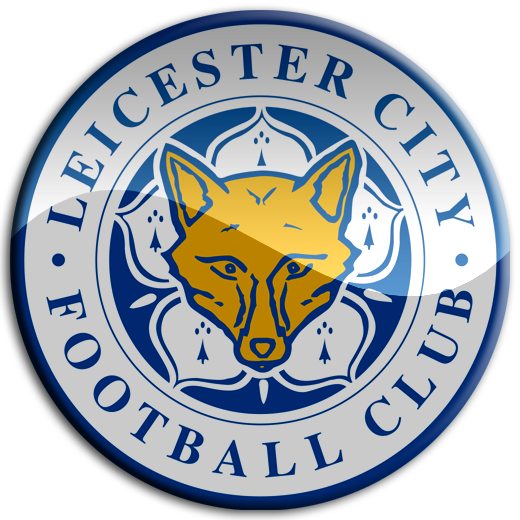
Details
- Name: Leicester City Football Club
- Nickname: The Foxes / City / Blue Army
- Founded: 1884 (as Leicester Fosse)
- Renamed: 1919 to Leicester City FC
- Ground: King Power Stadium
- Ground capacity: 32,262
The Stadiums
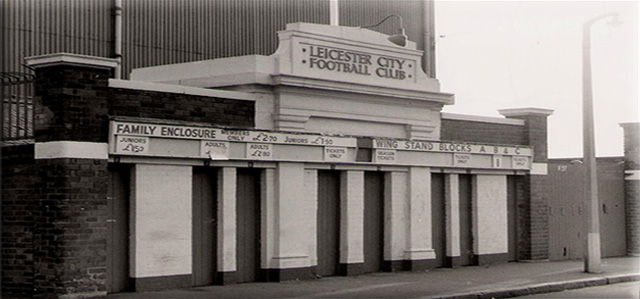
Filbert St Stadium
Tenants : Leicester City FC (1891–2002)
Capacity: 22,000 - Opened: 1891 - Closed: 2002
Early years
Leicester City was formed in 1884. The club was then named Leicester Fosse, as its founders mostly lived in the west end of the city, through which the Fosse Way ran. In 1884–85 it played at a ground known as the Racecourse, before sharing Victoria Park with the Leicester Tigers rugby club for two years. Leicester Fosse played at the Belgrave Road Cycle Track for a year, but returned Victoria Park after the rugby club offered a higher rent to the owners of the Cycle Track.
Leicester Fosse became a professional club in 1889 and laid out its own ground at Mill Lane, just north of Filbert Street. The club was soon forced to move, however, as the local Corporation requested the land for development. The site of what was to become Filbert Street was prepared during the summer of 1891, while Leicester Fosse temporarily played at the Aylestone Road Cricket Ground. Local legend suggests that the new ground was identified by a Miss Westland, the niece of one of the club's founders, Joseph Johnson.
The ground initially consisted of simple earth banks and a small Main Stand on the west side, until 1921, when a new and much larger Main Stand was built. In 1927, a new stand was built at the south end (known as the Spion Kop), and became known as the "Double Decker". The roof which had previously covered the Kop was rebuilt at the north, or Filbert Street end of the ground. It was in this form that Filbert Street saw its record attendance of 47,298 for the Fifth Round FA Cup tie, against Tottenham Hotspur, on 18 February 1928. This game also saw many more spectators watch the match from the roof of the Filbert Street end. The first phase of ground development concluded with the covering of the East or Popular side in 1939.
World War 2 and after
The middle section of the Main Stand suffered bomb damage in 1940, and was later further damaged by a serious fire. By 1949, the stand had been rebuilt, with much of the labour, ironically, being supplied by German POWs at a nearby camp. The ground's maximum capacity was now around 42,000. Floodlights were installed and first used for a match against German club Borussia Dortmund in October 1957.
After just surviving a council vote to terminate their lease in the late 1940s, City purchased the freehold of the ground in 1962, for the sum of £30,500. In 1971, the first moves towards an all-seater stadium were taken, as the North and East sides were converted to seating. Four years later, 20 basic executive boxes were added to the North Stand. A pioneering polythene cover was introduced to protect the pitch in 1971. The Air Dome covered an area of 90,000 square feet, weighed 24 cwt and took 15 men two hours to lay out and inflate using four electric fans. The Air Dome was removed in 1982.
All-seater stadium
At the beginning of the 1990s, after considering relocating to a new stadium, and a total redevelopment of Filbert Street which would have seen the pitch rotated by 90 degrees, onto the car park behind the Main Stand, City opted to build a new Main Stand.
Completed in December 1993, the Carling Stand held 9,500 seated spectators and expanded corporate facilities, costing £6million. In 1994, the final terraced area – the Kop – was converted to seating giving Filbert Street an all-seated capacity of 21,500, and bringing it into compliance with the Taylor Report which required all Premier League and Division One teams to have all-seater capacity.
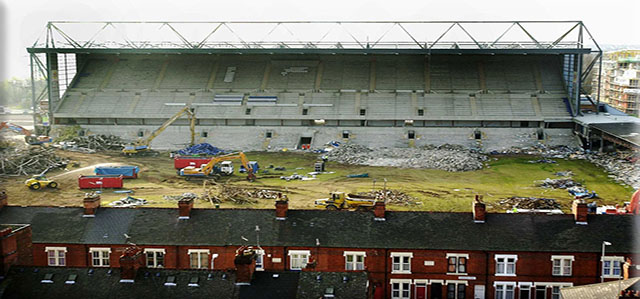
Relocation and demolition
Following the success of the club under Martin O'Neill during the later part of the 1990s, an expanded stadium was required for higher attendances and to provide better facilities. Expansion of Filbert Street would have been very difficult, as the North and East Stands backed onto housing which would have been expensive to place under a compulsory purchase order. Although expansion was considered, the club decided in 1998 to relocate. After a failed attempt to build a 40,000 all-seater stadium at Bede Island South (on the other bank of the nearby River Soar), the club purchased Freeman's Wharf, a former power station site 200 yards south of Filbert Street. Work began on a 32,500 seater stadium and it was opened in the summer of 2002.
Filbert Street was sold to a development company for £3.75 million in March 2002. The last game to be played at Filbert Street was the last game of the 2001–02 season, a 2–1 victory against Tottenham Hotspur. Matt Piper scored the last goal scored at the ground, bringing to an end 111 years of football there. In the autumn of 2002, Rotherham United expressed interest in purchasing the Carling Stand and moving it to their Millmoor stadium, but these plans were soon abandoned.
Demolition of Filbert Street was begun in March 2003. Part of the site is now home to the 'Filbert Village' development, built as accommodation for students for the nearby De Montfort University and University of Leicester. The road running through the development is called Lineker Road, named after one of Leicester City's most famous players. The rest of the site was meant to be developed for housing, but this work was cancelled due to the financial crisis of 2007–2008. It was then leased to a car parking company, but this arrangement was terminated by Leicester City Council in March 2012.

Gordon Banks springs into action here in his Leicester days, during a league clash with Manchester United in late 1965. Banks wasn't quite as adept in keeping the ball out of the net here, with champions United cantering to a 5-0 win.
King Power Stadium
Tenants : Leicester City FC (2002 - present day)
Capacity: 32,262 - Opened: 2002
The King Power Stadium is a football stadium located in Leicester, England. The ground which hosts home matches of English football club Leicester City, are currently playing in the Premier League. The all-seater stadium, inaugurated in July 2002, has a capacity of 32,262 and is the 19th largest stadium capacity in England. The stadium is named after King Power, a company owned by club owner Vichai Raksriaksorn.
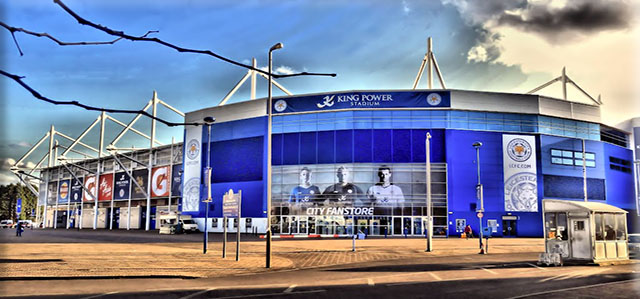
Background and construction
Leicester's previous stadium was at nearby Filbert Street, which had been their home since 1891. It was gradually upgraded during the 20th century and with the advent of the Taylor Report in January 1990 requiring all clubs in the top two divisions to have all-seater stadiums by August 1994, Leicester City's directors began to investigate the possibility of building a new stadium during the early 1990s, but initially decided to take the redevelopment option by building a new stand on one side of Filbert Street and fitting seats into the remaining standing areas, giving the stadium a 21,500 all-seated capacity by the 1994–95 season.
Filbert Street's conversion to an all-seater stadium coincided with their promotion to the Premier League after a seven-year exile from the top flight, and with their relegation after just one season it appeared that the 21,500 capacity would be adequate.
However, success in the late 1990s saw crowds rise, which meant that virtually every game at Filbert Street was a sell-out by the end of the decade. Relocation was soon back on the cards; several similar sized clubs had relocated to new stadiums around this time, including Leicester's midland rivals Stoke City and Derby County.
Some parts of the ground – the East and North Stands in particular – were also somewhat outdated, which led the manager, Martin O'Neill to joke that when he showed Filbert Street to new signings he led them backwards out of the players tunnel to prevent them from seeing the East Stand.
In early 1998 plans were announced for a 40,000 all-seater stadium to be built at Bede Island South in time for the 2000–01 season, but these plans were abandoned on 5 January 2000. Chairman John Elsom vowed that other options, including relocation to another site or even further redevelopment of Filbert Street, would be considered, hoping that either option would have materialised by August 2002.

The relocation option was soon settled upon, as plans were unveiled on 2 November 2000 for a 32,000-seat stadium at nearby Freeman's Wharf, with 2003–04 being the expected completion date, although it was suggested at the time relocation could happen at the start of the 2002–03 season. Work on the stadium began in the summer of 2001, and by 10 October that year it was confirmed that the new stadium would be ready for the 2002–03 season.
The stadium was completed on time in the summer of 2002, ready for Leicester to take up residence for the start of the 2002–03 season. However, it was not an easy start at their new stadium as they had just been relegated from the Premier League and were more than £30million in debt. The stadium also has under-soil heating.
The record attendance for football is 32,188 for Leicester City against Real Madrid in a pre-season friendly game in the summer of 2011. The overall record attendance is 32,488 for a rugby union match between Leicester Tigers and Bath in 2006. This is because this rugby match took place prior to seats being removed to provide segregation of rival football fans, reducing the capacity of the ground from exactly 32,500 to 32,262.
Opening
The stadium was officially opened by former Leicester striker Gary Lineker on 23 July 2002. He used a giant pair of scissors to cut a ribbon on the pitch after arriving at the stadium in a Walkers lorry. The first game at the new stadium was a friendly against Spanish team Athletic Bilbao, on 4 August 2002. The game finished 1–1, with Tiko scoring the first goal at the stadium, and Jordan Stewart scoring Leicester's first goal. The attendance was approximately 24,000 (no official figure was recorded due to a computer problem). The first competitive match took place six days later and Leicester beat Watford 2–0 in front of a near-capacity crowd of 31,022. Brian Deane scored both goals, including the stadium's first in competitive games. Leicester ended the 2002–03 season promoted back to the Premier League, losing just two home games in the season, despite spending the early part of the season in receivership due to their huge debts, until a takeover deal was completed.
Ownership
The £37 million cost of the new stadium, combined with relegation from the Premiership, the collapse of the English transfer market due to the introduction of the transfer window and the collapse of ITV Digital meant that Leicester went into receivership shortly after moving to the new stadium. Birse Construction who had built the stadium therefore lost a large part of their fee, and they withdrew from any further football ground construction. The main losers from this were Leicester's local rivals Coventry City, who were in negotiations with Birse to build their own new stadium.
As part of the deal which brought the club out of receivership, the ownership of the stadium reverted to American company Teachers Insurance, who had supplied £28 million via a bond scheme towards the stadium's construction, with the club taking a long-term lease while the bond repayments were made.
On 1 March 2013, Leicester City's Thai owners King Power bought the ground through their company K Power Holdings Co, Ltd.
Plans
In October 2006, Milan Mandarić reportedly offered £25 million to buy Leicester City. This was said to include £15 million to buy back the stadium from its current owners. Mandarić stated in the local newspaper, The Leicester Mercury, that he envisioned Leicester City becoming a powerful club and the stadium, possibly within the next few years, could have a capacity of 45,000. The stadium at full strength (if renovated to full potential) could hold up to 55,000. However, this would only happen if Leicester became a regular top-six Premier League side, according to LCFC.
Naming
In 2002, former Leicester City shirt sponsors Walkers signed a ten-year deal for naming rights. The agreement was superseded halfway through the period, in May 2007, when they again paid a "seven-figure sum" to extend their sponsorship of the stadium until 2017. Originally the ground was to have been called the "Walkers Bowl", but that name was dropped after a fans' petition against it. Fans criticised the name for having only the name of the sponsor in it, and no Leicester City reference, such as "Filbert", "Fosse" or "Foxes", while some fans objected to "Walker's Bowl" on the grounds that they thought it was ridiculous and too "American". As a result of the petition, the name was quickly changed to the "Walkers Stadium"; however, some fans were still unhappy with the name, and it was sometimes referred to (usually derogatively) as the "crisp bowl", in reference to Walkers best known products. Many fans refer to the stadium as Filbert Way after the ground's address, retaining a link with the past. The naming rights were sold to King Power for the 2011–12 season.
Club Legend - Arthur Rowley
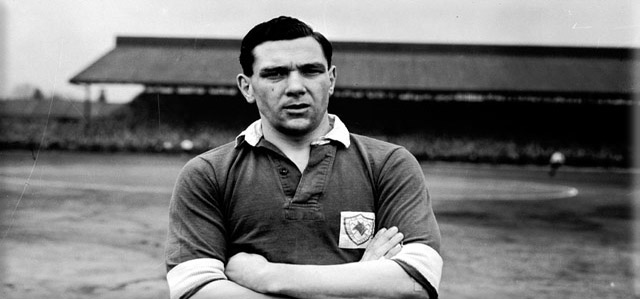
Even by his own admission, there was little particularly remarkable about George Arthur Rowley. The boy from the Black Country stood a respectable but hardly imposing five foot 11 inches tall and tipped the scales at just over 13 stone. He was not blessed with searing natural pace and throughout his professional career he survived on fighting spirit rather than finesse.
And yet in 19 seasons of unflinching service for West Bromwich Albion, Fulham, Leicester City and finally Shrewsbury Town, the unassuming striker amassed a phenomenal 434 league goals in 619 games and to this day, he remains the Football League's leading scorer.
By comparison the legendary Dixie Dean, the post-War era's second most prolific marksman, registered a mere 379.
"He was never feted as a star and he was outshone by his brother Jack, of Manchester United and England fame," said The Independent in his obituary in 2002. "But the fact remains that no one in the history of English League football has popped the ball into the net more times than Arthur Rowley.
"Fearsomely combative in the air, a dreadnought at ground level and with a savage left-foot shot, Rowley was a single-minded goal machine whose final haul surely would have been even more bountiful had his teenage years not coincided with the Second World War."
Born in Wolverhampton in 1926, Rowley's father had played in goal for Walsall but his son was more interested in scoring goals than stopping them and at the age of 14, he headed north to train with Manchester United.
The War soon curtailed his Old Trafford sojourn but when peace finally broke out, the teenager signed his first professional contract with West Bromwich Albion and not United. Deployed out of position on the left wing, the Hawthorns was not to be a happy hunting ground and in 1948 after two modest seasons, he was sold to Fulham and it was there that his career truly exploded into life. Cottagers Manager Frank Osborne played Rowley up front and the rewards were instant as he scored 19 times in just 22 league appearances to help the club claim the Second Division championship and promotion to the top-flight.
In 1950, he joined Leicester City in a £12,000 deal for what was to be the most prolific phase of his record-breaking career. In total, Rowley played nine seasons at Filbert Street and not once did his tally for a league campaign dip below the 20-goal mark. In 1956/57, he scored 44 times in 42 games, including four hat-tricks, as the club earned promotion and he remains the Foxes' second all-time league marksman with 251, just eight behind Arthur Chandler.
"Prolific, lethal and profuse are all words that have been used to describe the amazing talents of City legend Arthur Rowley," wrote the club website after his death at the age of 76. "His heroic status through his hat-tricks and appetite for hitting the back of the net rank him as an all-time favourite for Foxes fans."
International recognition however still eluded him. An England B cap against Switzerland in March 1956 was the closest he came to emulating his older brother and although he also appeared for a Football League XI against an Irish League team later the same year, it was to be as a club player that he continued to forge his legend. He finally parted company with Leicester in 1958 to become Shrewsbury Town Player-Manager. Aged 33, Rowley could have been forgiven for contemplating retirement but in his first season with the Shrews, he found the back of the net 38 times in 43 games to inspire the club to promotion from the newly-formed Fourth Division.
As the years rolled by, the weight piled on and by the end of his playing days at Gay Meadow, Rowley frequently picked himself in central defence rather than up front. However, by the time he finally hung his boots in 1965, he had still laid claim to 152 goals in 236 appearances for Shrewsbury. He remained with the Shrews as Manager for three more years before an ill-fated and brief spell as joint Manager with John Harris at Sheffield United. He then took up the reins at Southend United, leading the club to promotion to the Third Division in the 1971/72 season.
He ended his managerial career in 1976, working as a District Manager for Vernons Pools before retiring, but it was as a wholehearted, startlingly prolific and reassuringly old-fashioned centre forward that Rowley will be most fondly remembered.

Steve Cooper

The Facts
Leicester City Football Club also known as the Foxes, is an English professional football club based in Leicester at the King Power Stadium.
They will play in the Premier League in the 2014–15 season, having been promoted as champions of the Football League Championship in 2013–14.
The club was founded in 1884 as Leicester Fosse, playing on a field near Fosse Road.
They moved to Filbert Street in 1891 and played there for 111 years, before moving again, this time to the nearby Walkers Stadium in 2002.
Leicester City were elected to the Football League in 1894.
The club's highest ever finish was second place in the top flight, in Division One in 1928–29.
The club holds a joint-highest seven second tier titles (six Second Division and one Championship), as well as one League One title.
They have won the League Cup three times and have been FA Cup runners-up four times, a tournament record for the most defeats in the final without having won the competition.
The club has only spent one season outside the top two tiers of English football in the 2008/09 season.
For further information check out their Official website
The History
Formed in 1884 by a group of old boys of Wyggeston School as "Leicester Fosse", the club joined the Football Association in 1890. Before moving to Filbert Street in 1891, the club played at five different grounds, including Victoria Park south-east of the city centre and the Belgrave Road Cricket and Bicycle Grounds.
The club also joined the Midland League in 1891, and was elected to Division Two of the Football League in 1894 after finishing second. Leicester's first ever Football League game was a 4–3 defeat at Grimsby Town, with a first League win the following week, against Rotherham United at Filbert Street. The same season also saw the club's largest win to date, a 13–0 victory over Notts Olympic in an FA Cup qualifying game. In 1907–08 the club finished as Second Division runners-up, gaining promotion to the First Division, the highest level of English football. However, the club were relegated after a single season which included the club's record defeat, a 12–0 loss against Nottingham Forest.
In 1919, when League football resumed after World War I, Leicester Fosse ceased trading due to financial difficulties of which little is known. The club was reformed as "Leicester City Football Club", particularly appropriate as the borough of Leicester had recently been given city status.
Following the name change, the club enjoyed moderate success in the 1920s; under the management of Peter Hodge, who left in May 1926 to be replaced two months later by Willie Orr, and with record goalscorer Arthur Chandler in the side, they won the Division Two title in 1924–25 and recorded their highest ever league finish in 1928–29 as runners-up by a single point to Sheffield Wednesday. However the 1930s saw a downturn in fortunes, with the club relegated in 1934–35and, after promotion in 1936–37, another relegation in 1938–39 would see them finish the decade in Division Two.
City reached the FA Cup final for the first time in their history in 1949, losing 3–1 to Wolverhampton Wanderers. However, the club was celebrating a week later when a draw on the last day of the season ensured survival in Division Two. Leicester won the Division Two championship in 1954, with the help of Arthur Rowley, one of the club's most prolific strikers. Although they were relegated from Division One the next season, under Dave Halliday they returned in 1957, with Rowley scoring a club record 44 goals in one season. Leicester remained in Division One until 1969, their longest period ever in the top flight.
Under the management of Matt Gillies and his assistant Bert Johnson, Leicester reached the FA Cup final on another two occasions, but lost in both 1961 and 1963. As they lost to double winners Tottenham in 1961, they were England's representatives in the 1961–62 European Cup Winners' Cup. In the 1962–63 season, the club reached as high as first place in the First Division, thanks to a sensational run of form on icy and frozen pitches the club became nicknamed the "Ice Kings" eventually placed fourth, the club's best post-war finish. Gillies collected silverware in 1964, when Leicester beat Stoke 4–3 on aggregate to win the League Cup for the first time.
Leicester also reached the League Cup final the following year, but lost 3–2 on aggregate to Chelsea. Gillies and Johnson became hugely influential on English football for their version of the "whirl" and the "switch" system which utterly upset the traditional 1–11 formations in England. After a bad start to the season, Matt Gillies resigned in November 1968. His successor, Frank O'Farrell was unable to prevent relegation, but the club reached the FA Cup final in 1969 for the last time to date, losing to Manchester City 1–0.
In 1971, Leicester were promoted back to Division One, and won the Charity Shield for the only time.Unusually, due to Division One champions Arsenal's commitments in European competition, Division Two winners Leicester were invited to play FA Cup runners up Liverpool, beating them 1–0. Jimmy Bloomfield was appointed for the new season, and his team remained in the First Division for his tenure. No period since Bloomfield has seen the club remain in the top division for so long. Leicester reached the FA Cup semi-final in 1973–74.
Frank McLintock, a noted player for seven years for Leicester successful period from the late Fifties to the mid Sixties, succeeded Jimmy Bloomfield in 1977. City was relegated at the end of the 1977–78 season and McLintock resigned. Jock Wallace resumed the tradition of successful Scottish managers (after Peter Hodge and Matt Gillies) by steering Leicester to the Division Two championship in 1980. Unfortunately, Wallace was unable to keep Leicester in Division One, but they reached the FA Cup semi-final in 1982.
Under Wallace, one of City's most famous home-grown players, Gary Lineker, emerged into the first team squad. Leicester's next manager was Gordon Milne, who achieved promotion in 1983. Lineker helped Leicester maintain their place in the First Division but was sold to Everton in 1985 and two years later Leicester were relegated, having failed to find a suitable replacement. Milne left in 1986 and was replaced in 1987 by David Pleat, who was sacked in January 1991 after a defeat that left City fourth from bottom. Gordon Lee was put in charge of the club until the end of the season. Leicester won their final game of the season, which guided them clear of relegation to the third tier of the football league.
Brian Little took over in 1991 and by the end of the 1991–92 season Leicester had reached the playoff final for promotion to the newly formed Premiership, losing to Blackburn Rovers. The club also reached the playoff final the following year, losing 4–3 to Swindon Town, having come back from 3–0 down. In 1993–94 City were promoted from the playoffs, beating Derby County 2–1 in the final. Little quit as Leicester manager the following November to take charge at Aston Villa, and his successor Mark McGhee was unable to save Leicester from finishing second from bottom in the 1994–95 season. McGhee left the club unexpectedly in December 1995 whilst Leicester were top of Division One to take charge of Wolverhampton Wanderers.
McGhee was replaced by Martin O'Neill. Under O'Neill, Leicester qualified for the 1995–96 Division One promotion playoffs and beat Crystal Palace 2–1 with a last-gasp Steve Claridge goal securing an immediate return to the Premiership. Following promotion, Leicester established themselves in the Premiership with four successive top ten finishes. O'Neill was the first manager to win silverware for 26 years, winning the League Cup twice, in 1997 and 2000, and Leicester were runners-up in 1999. Thus the club qualified for the UEFA Cup in 1997–98 and 2000–01, the club's first European competition since 1961. In June 2000 O'Neill was lured to Celtic.
O'Neill was replaced by former England U-21 coach Peter Taylor. During this time, Leicester's last European appearance ended in a 3–1 defeat to Red Star Belgrade on 28 September 2000 in the 2001 UEFA Cup. After a long run of poor results, Taylor was sacked in October 2001. Taylor was replaced by a management team of Dave Bassett and Micky Adams, but they could not prevent City's last season at Filbert Street ending in relegation from the Premiership.
Leicester moved into the new 32,500-seat Walkers Stadium at the start of the 2002–03 season. Walkers, the Leicestershire based crisp manufacturers, acquired the naming rights for a ten-year period. In October 2002, the club went into administration with debts of £30 million. Some of the reasons were the loss of TV money (ITV Digital, itself in administration, had promised money to First Division clubs for TV rights), the large wage bill, lower than expected fees for players transferred to other clubs and the £37 million cost of the new stadium.
Adams was banned from the transfer market for most of the season, even after the club was rescued by a takeover by a consortium led by Gary Lineker. Adams guided Leicester to runners-up spot in Division One and automatic promotion back to the Premiership with more than 90 points. Leicester only lasted one season in the top flight and were relegated back to the newly labelled Championship, previously known as Division One.
When Adams resigned as manager in October 2004 Craig Levein was appointed boss. This would prove to be an unsuccessful period and after 15 months in charge and flirting with relegation Levein was sacked. Assistant manager Rob Kelly, took over as caretaker manager, and after winning three out of four games was appointed to see out the rest of the season. Kelly steered Leicester to safety and in April 2006 was given the manager's job on a permanent basis.
In October 2006, ex-Portsmouth chairman Milan Mandarić was quoted as saying he was interested in buying the club, reportedly at a price of around £6 million with the current playing squad valued at roughly £4.2 million. The takeover was formally announced on 13 February 2007. On 11 April 2007, Rob Kelly was sacked as manager and Nigel Worthington appointed as caretaker manager until the end of the season. Worthington saved the club from relegation, but was not offered the job on a permanent basis. On 25 May 2007 the club announced former MK Dons manager Martin Allen as their new manager with a three-year contract.
Allen's relationship with Mandarić became tense and after only four games Allen left by mutual consent on 29 August 2007. On 13 September 2007, Mandarić announced Gary Megson as the new manager of the club, citing Megson's "wealth of experience" as a deciding factor in the appointment. However, Megson left on 24 October 2007 after only six weeks in charge, following an approach made for his services by Bolton Wanderers. Mandarić placed Frank Burrows and Gerry Taggart in the shared position as caretaker managers until a professional manager was appointed.
On 22 November, Ian Holloway was appointed manager. Holloway made history when he became the first Leicester manager in over 50 years to win his first league game in charge, beating Bristol City 2–0. Despite this, Leicester were relegated from the Championship at the end of the 2007–08 season after drawing 0–0 with Stoke City, marking the 2008–09 season as Leicester's first season outside the top two tiers of English football. Their fall from grace would also see Holloway leave by mutual consent after less than a season at the club, being replaced by Nigel Pearson.
The club returned to the Championship at the first attempt, finishing as champions of League One after a 2–0 win at Southend United with 2 games in hand. The 2009–2010 season saw Leicester's revival under Pearson continue, as the club finished 5th and reached the Championship play-offs in their first season back in the second tier. Though after a battling performance coming from 2–0 down on aggregate, away to Cardiff City, to briefly lead 3–2, they eventually lost to a penalty shoot-out in the play-off semi-final.
On Tuesday 29 June 2010, it was confirmed that Nigel Pearson had left Leicester to become the manager of Hull City because he felt that the club seemed reluctant to keep him, and that Paulo Sousa had been the club's guest at both play-off games, hinting at a possible replacement. On Wednesday 7 July 2010, Paulo Sousa was confirmed as Pearson's replacement.
In August 2010, following agreement on a three-year shirt sponsorship deal with duty-free retailers the King Power Group, Mandarić sold the club to a Thai-led consortium named Asian Football Investments (AFI) fronted by King Power Group's Vichai Raksriaksorn. Mandarić, an investor in AFI, was retained as club chairman.
On 1 October 2010, after a poor start that saw Leicester bottom of the Championship with only one win out of the first 9 league games, Paulo Sousa was sacked by the club with immediate effect. Two days later, Sven-Göran Eriksson, who had been approached by the club after the 6–1 loss to then bottom-of-the-table Portsmouth two weeks earlier, was appointed as his replacement, signing a two-year contract with the club. On 10 February 2011, Vichai Raksriaksorn, part of the Thai-based Asia Football Investments consortium, was appointed new chairman of the club after Mandarić left in November to take over Sheffield Wednesday.
Leicester were viewed as one of the favourites for promotion in the 2011–12 season, but on 24 October 2011, following an inconsistent start with the Foxes winning just 5 out of their first 13 games, Sven-Göran Eriksson left the club by mutual consent. Three weeks later, on 15 November 2011, Nigel Pearson was confirmed to be returning to the club as Eriksson's successor.
Pearson would go on to lead The Foxes to a 6th place finish in the 2012–2013 season, ensuring Leicester City were in the Championship play off's after a last gasp 3–2 away win at local rivals Nottingham Forest. However they would go on to lose out in the play off semi final 3–2 on aggregate to Watford after Anthony Knockaert missed a late penalty and Troy Deeney scored right at the end after a swift counterattack from a Manuel Almunia double save.
In April 2014, a 2–1 win over Sheffield Wednesday, combined with losses by Queens Park Rangers and Derby County, allowed Leicester City to clinch a promotion to the Premier League after a 10 year absence.
On 22 April 2014, a 1–0 victory over Bolton Wanderers FC at the Reebok Stadium saw Leicester become the champions of the 2013-14 Football League Championship.
After a difficult 2014-15 season in the Premier League, Leicester made a remarkable recovery escaping relegation after looking doomed, not to mention securing more points than any other team in the final 9 matches, but it wasn't enough to save Nigel Pearson, who was sacked on June 31st 2015 with the club stating "The working relationship between him and the club's board was "no longer viable".
Leicester placed Steve Walsh and Craig Shakespeare, the joint assistant managers, in temporary charge of first-team duties while they began the process of recruiting a replacement for Pearson.
On July 13th 2015, Leicester City announced Claudio Ranieri as the Club’s new First Team Manager.
Leicester City won The Premier League on 2nd May 2015 after Runners Up Spurs failed to beat Chelsea.
The following season, Ranieri was sacked, after league form saw Leicester a little too close to the relegation zone.
On 12 March 2017 Craig Shakespeare was named as the new manager of Leicester City.
On 17th October 2017, Leicester sacked Shakespeare, leaving Michael Appleton will take caretaker charge of the squad.
Leicester appointed Claude Puel on a 3 year deal on 25th October 2017. Puel lasted just 16 months, as on 24th February 2019, Leicester City announced they had sacked their manager.
On 26th February 2019, Leicester City announced that Brendan Rodgers had taken over as manager, signing a contract until June 2022.
On 15th May 2021, Leicester beat Chelsea 1-0 to win the 2020-21 FA Cup.
On 2nd April 2023, Leicester parted company with Brendan Rodgers, and on 10th April 2023 appointed Dean Smith as temporary manager until the end of the season. Leicester City were relegated as a consequence of Everton's 1–0 home victory over AFC Bournemouth. This ended the club's nine-year stint in the Premier League, making them only the second former Premier League champions to be relegated from the league since it began in 1992–93, following Blackburn Rovers in 1998–99.
On 16 June 2023, Enzo Maresca was appointed as the club's new manager ahead of the 2023–24 EFL Championship season. Leicester went on to make their best start to a league season, and the best since the league became known as the Championship in 2004–05. They were promoted back to the Premier League as champions at the first attempt. This was also their eighth second tier title which is a record for the division.
Notable Players
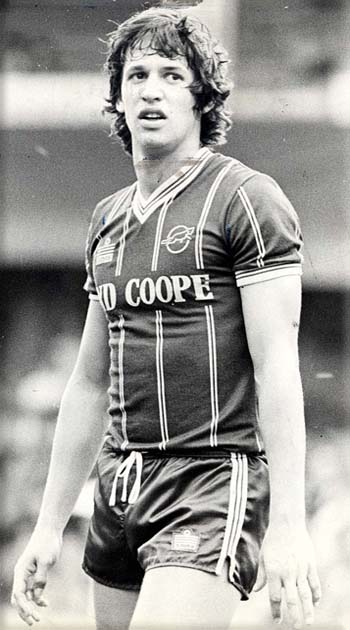
Gary Lineaker - Leicester City 1978 to 1985

David Nish - Leicester City - 1966 to 1972



















